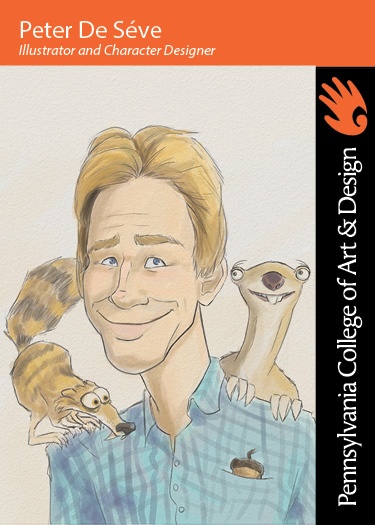
Artist Spotlight: Peter De Séve
Monday, May 4th, 2015
Peter De Séve discovered his passion for art at an early age. He began drawing as a young child, inspired by the comic books he collected as well as science fiction and fantasy illustration.
Since then, he has come a long way and has an amazing portfolio of illustrations created for The New Yorker, Disney, Blue Sky Studios, Totoro Forest Project and many more. De Séve uses fairy tales and animals metaphorically to liven up otherwise dry subject matter. Not only are his drawings phenomenal, but his ideas are incredible as well. Some of his best known works are the character designs for the Ice Age series, Mulan, A Bug’s Life and Finding Nemo.
In 2002, De Séve received the distinguished Hamilton King Award from the Society of Illustrators. His wonderful and humorous art work can be seen today in A Sketchy Past. This 240-page book is a collection of his finest work, all watercolor, and lots of fun sketches. He currently lives in Brooklyn, New York, with his wife and daughter.
Born: 1958, Queens, NY
Famous work: Character designs for the Ice Age series
Facts about Peter De Séve:
- Peter De Séve is an Illustrator and Character Designer, best known for his illustrated covers for The New Yorker.
- He is also famous for his character designs for the Ice Age films.
- He has received multiple awards including: an Emmy Award for Outstanding Character Design, the National Cartoonists Society Magazine Illustration Award in 2000, the Hamilton King Award from the Society of Illustrators, a Clio Award for the Nike television commercial, a Spectrum Annual of Fantastic Art gold medal, a Soleil d’Or award from the Festival BD Sollies-Ville in France, and a Visual Effects Society Award nominated for outstanding animated character design for Ice Age: Dawn of the Dinosaurs.
- He is part of the Directors Collective Hornet Incorporated company.
Quote: “Drawing from the imagination is not the same as drawing from life and writing book reviews is not the same as writing a short story. But the critical thinking needed to write a book review can help inform a work of fiction, the same way drawing a real person can help you better depict one who is wholly invented.”
Peter De Séve illustration by Aurelie Wagner, ’14
